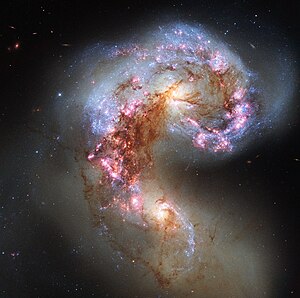Antennae Galaxies
| Antennae Galaxies | |
|---|---|

NGC 4038 (left) and NGC 4039 (right)
|
|
| Observation data (J2000 epoch) | |
| Constellation | Corvus |
| Right ascension | 12h 01m 53.0s / 12h 01m 53.6s |
| Declination | −18° 52′ 10″ / −18° 53′ 11″ |
| Redshift | 1642 ± 12 / 1641 ± 9 km/s |
| Distance | 45 Mly / 65 Mly |
| Apparent magnitude (V) | 11.2 / 11.1 |
| Characteristics | |
| Type | SB(s)m pec / SA(s)m pec |
| Apparent size (V) | 5′.2 × 3′.1 / 3′.1 × 1′.6 |
| Notable features | Interacting galaxies |
| Other designations | |
| Ringtail Galaxy,NGC 4038 / 4039, PGC 37967 / 37969, Arp 244,Caldwell 60/61 |
|
The Antennae Galaxies, also known as NGC 4038/NGC 4039, are a pair of interacting galaxies in the constellation Corvus. They are currently going through a starburst phase, in which the collision of clouds of gas and dust, with entangled magnetic fields, causes rapid star formation. They were discovered by William Herschel in 1785. NGC 4038 is located at RA 12h 01m 53.0s, Dec −18° 52′ 10″; and NGC 4039 at RA 12h 01m 53.6s, Dec −18° 53′ 11″.
The Antennae Galaxies are undergoing a galactic collision. Located in the NGC 4038 group with five other galaxies, these two galaxies are known as the Antennae Galaxies because the two long tails of stars, gas and dust ejected from the galaxies as a result of the collision resemble an insect's antennae. The nuclei of the two galaxies are joining to become one giant galaxy. Most galaxies probably undergo at least one significant collision in their lifetimes. This is likely the future of our Milky Way when it collides with the Andromeda Galaxy.
Five supernovae have been discovered in NGC 4038: SN 1921A, SN 1974E, SN 2004GT, SN 2007sr and SN 2013dk.
A recent study finds that these interacting galaxies are less remote from the Milky Way than previously thought—at 45 million light-years instead of 65 million light-years.
...
Wikipedia
